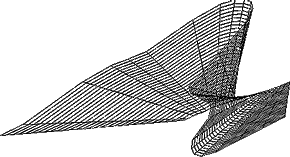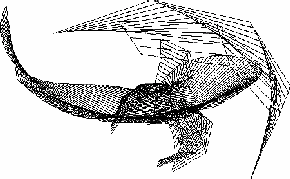Entwürfe für die Schneckenhäuser von Schlittenfahrt

Mein Architekten

2005.12.12 19:46
Architecture as Signal
Mein Architekten

Über Alles!

| |
2006.01.18 13:00
what is the good source to study folding architecture?
And here I thought that folding architecture had to do with simply taking a building plan and then folding it. Boy, I'm glad I never told anyone else this before because they'd surely think I was just plain stupid. I mean, I didn't know that the point was not so much to fold, but rather to tie architecture up in theoretical knots where even the architects doing it don't even know that what they are really doing is advertising (more than selling) what they think is a definite Zeitgeist reality. And what? Now it's just a quondam trend or fad that's still over-intellectualized.
2006.01.18 17:39
what is the good source to study folding architecture?
MMatt wrote:
"What French is trying to make sure everyone understands here is that "folding" isn't a technique or a style, it's an entire school of thought (philosophically) with just as much theory and thick readings to defend/quantify it as any decon or other pomo sub-strands."
Personally, I've lost most of the confidence I've ever had in this type of sentiment/position as it relates to architectural design. Nonetheless, what MMatt wrote does reflect how most student architects are now trained to think about design, technique or style.
Yet, when it really comes down to an architectural design, folding architecture really does boil down to what it looks like. So, as far as I'm concerned, folding architecture is just another form, in the long history of forms, that architecture can take on, and, like jlxarchitect says, "if it can solve my office's project's problem, then it is Ok to use."
Otherwise, the notion of "an entire school of [failed?] thought" is stillborn, rather than being something within the evolutionary continuum of architectural design. And just because it's what is taught in school doesn't necessarily make it the truth. For example, the "Metabolist" architects of Japan talked a lot about architecture reflecting "life giving" forms, while at the same time appearing oblivious to the fact that metabolism as a operation is a creative/destructive duality. Likewise, everything Tafuri and Eisenman said/say about Piranesi's Ichnographia Campus Martius is just plain incorrect, yet their mistakes are taught and published over and over again.
I hope you all now understand what I mean by saying that I've lost confidence...
2006.01.20 20:14
what is the good source to study folding architecture?
I agree with your views of Adaptation, and the brief overlap with Being John Malkovich further adds to the folding. Being John Malkovich might also be regarded as a film that folds, (actually, I see a comparability between Adaptation and Saving Grace--orchids, desperation and drugs--but Saving Grace is more of an unfolding that doesn't fold back in on itself until the very end), but there is another structural element within Adaptation that needs addressing, namely its continual use of [the] double theater--the two brothers, the book and the screenplay, the two lives of the author: Susan and Suzie Q., and the overall blurring of the real and the virtual. CQ is another movie where double theatrics is the overall structure.
I now wonder whether what is today seen as folding may more accurately be double theatrics. Granted, however, [the] double theater necessarily employs (at least) one fold, especially in the Baroque.
The following is from Timothy Kitao, Circle and Oval in St. Peter's Square, 1974:
"In the well known production of the DUE TEATRI, first given in 1637, Bernini developed a simulated amphitheater of a very elaborate kind. This is, of course, the best known of Bernini's theatrical works, but a recapitulation is in order.
According to Massimiliano Montecuculi, who witnessed the performance, the stage was prepared with "a flock of people partly real and partly feigned" so arranged that, when the curtain had fallen for the opening of the play, the audience saw on the stage another large audience who had come to see the comedy. Two braggarts, played by Bernini himself and his brother Luigi, then appeared on the stage, one facing the real audience and the other the fictitious; and recognizing each other in no time, they went on to claim, each in turn, that what the other saw as real was actually illusory, each firmly convinced that there was no more than one theater with its audience in that half he was facing. The confusions of realities in mirror image thus heightened, the two firmly decided "that they would pull the curtain across the scene and arrange a performance each for his own audience alone." Then the play was performed to the real audience, that is, the main act to which that preceded was only a pleasant prelude. But through the play another performance was supposed to be taking place simultaneously on the second stage introduced by Luigi; the play was, in fact, interrupted at times by the laughter from those on the other side, as if something very pleasant had been seen or heard.
At the end of the play, the two braggarts reappeared on the stage together to reaffirm the "reality" of the illusion. Having asked each other how they fared, the impresario of the fictitious performance answered nonchalantly that he had not really shown anything but the audience getting up to leave "with their carriages and horses accompanied by a great number of lights and torches." Then, drawing the curtain, he displayed the scene he had just said he had shown to his audience, thus rendering complete the incredible reversal of reality and illusion to the confused amazement of the real spectators, who were now finding themselves ready to leave and caught in the enchanting act of feigning the feigned spectators."
The two theaters are definitely hinged, and there lies the fold, but the results are more complex than merely a hinge or a fold. In 2000 I wrote, "Bernini's theatrical performance manifests the Baroque's consummate ending. Within his double theater Bernini capsulized the beginning of Western culture's new bifurcation of the real and the illusory, introduced mirroring as a henceforth dominant Baroque (stylistic) theme, and, at base, inverted reality into a reenactment of its own illusory mirror (--is this perhaps also the genesis of historiography?)."
My point now would be to go back to Baroque architecture not only with the fold in mind, but looking for the double theater that is probably even more there.
Around this time in 2002 I was researching and writing "Theatrics Times Two" and "Theatrics Times Two, too" but I don't think the fold was ever involved. Interestingly, amphitheater literally means 'theater with both sides' and double theaters go back at least a couple millennia--from an online source:
"Slightly off the subject, but too interesting to pass up, is the story of another theater, which was built in 53 BC (i.e., at the time when Pompey's theater was under construction) by Caius Scribonius Curio for his father's funerary games. It was actually a double theater--two wooden theaters set back to back to allow for two simultaneous dramatic performances. But the two theaters were set on pivots so that they could be rotated, audiences and all, and when face to face they made an elliptical amphitheater ("amphi" means "on both sides") for gladiatorial games. Curio's "amphitheater" is the first one documented and he (or an architect he employed) may have been the inventor of the concept. Pliny the Elder documents it in Book 36, section 117, of his Natural History, but I've only found it in Latin on the Internet."
| |
2006.01.26 11:02
To err is ummm eh Human?
"The photos are better than the real thing..i think.."
So, the virtual is better than the real?
2006.02.16 11:02
division isolation separation boundaries oh my!!
I'm gradually getting into an architecture that crosses boundaries.
division isolation separation boundaries oh my!!
2006.02.17 15:01
division isolation separation boundaries oh my!!
The wall of Wall House 2 has been replaced with the main facade of the Gooding House, Venturi and Rauch, Absecon, 1977.
2006.02.18 14:14
Architecture as a Cult
Better to turn the house into an architecture cult museum.

2006.02.19 14:42
Iconography, or the problem of representation
Bad Hair Day Architecture

Yeah, reality bites.
Venus Fly Trap Architecture

Gosh, reality really bites.
These are just two examples of how Quondam can help your architecture in today's chaotic world. Do you have ultra-original architecture that no one can easily understand? Then don't worry! Quondam can look at your project and within minutes provide you with the right visual formula to present your great design to the world.
|